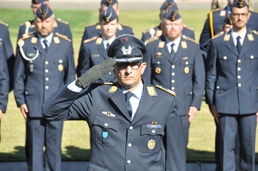
By Wendy Brown
Fort Bliss Bugle Editor
The German National Day of Mourning commemorates all victims of violence and war, those persecuted and killed because people considered them different and those who lost their lives because they stood up against tyranny, among others.
Lt. Col. Martin Herter, deputy commander of the German Air Force Air Defense Center, didn’t have to look far for examples as he delivered the keynote speech during a ceremony at Fort Bliss National Cemetery Nov. 13, 2016.
Near the cemetery’s south entrance stand the headstones of 26 Germans buried after World War II, and Herter told the audience about the men.
“The youngest was 21 and the oldest soldier was 47,” Herter said. “They were all sergeants and corporals. There is a standard certificate of death available for everybody. On this certificate is the immediate cause of death, date, time and place of death stated.”
They were prisoners of war in Roswell, Lordsburg and Artesia, New Mexico, and Yuma, Pinal and Phoenix, Arizona, Herter said. Most of them died in a hospital, and two of them died at William Beaumont Army Medical Center here.
One of the men was Werner Drechsler, a former German U-boat crewman who cooperated with his captors and became a spy for the allies, Herter said. Drechsler collected information about German submarine technology, operational procedures and tactics and other useful intelligence.
Drechsler had a reason to help the allies: his father had spent time in one of Hitler’s concentration camps as a political prisoner, Herter said.
On March 12, 1944, however, authorities transferred Drechsler to a POW camp in Arizona that included some of his former crewmates who knew of his spying activities, Herter said. Word quickly spread throughout the camp.
“Next morning Drechsler was found hanging in the shower room,” Herter said. “He had been murdered within hours of arrival at the camp.”
Another man committed suicide by jumping in front of a train, and another died after a farmer shot him for stealing his car during an escape attempt, Herter said.
“All these stories of the persons buried next to us tell about a very bad time during World War II,” Herter said. “With these stories you can somehow try to imagine how horrible the time of violence, destruction, crime, dictatorship, horror, tyranny and annihilation of peoples must have been.”
About 100 German soldiers attended, as well as several other German citizens and Americans. Members of the 1st Armored Division Band performed the U.S. and German national anthems, “Goin’ Home,” “Holst Suite Number 2 – Song Without Words” and “Der Gute Kamerad.”
Members of the German military observe the day, called the “Volkstrauertag” in German, wherever they are stationed around the globe, and a large ceremony takes place in the German capital of Berlin, said German Sgt. Maj. Peter Breuer, a GAFADC spokesman.
Germans recognize the day each year two Sundays before the first day of advent, and it is supposed to be a day of quiet and silent remembrance, Breuer said. Germans are not allowed to hold public events with music and dance that day. The first official observance took place in Berlin in 1922.
Herter said we have the privilege of living in freedom and peace in the U.S. and Germany, and we should never take it for granted.
“Establishing, keeping and defending peace is the challenge for every single one of us, but especially for us as soldiers,” Herter said. “A decent and humane life is only possible in peace and freedom. This is our task – today, tomorrow and the day after tomorrow.”